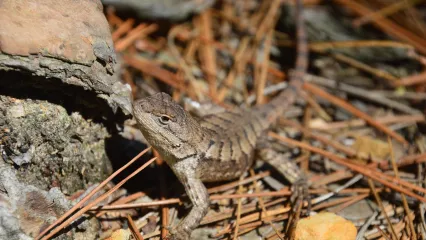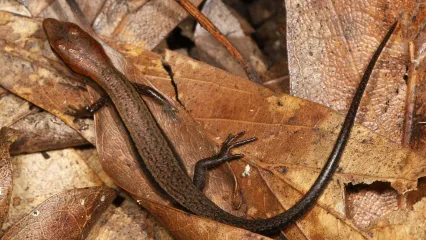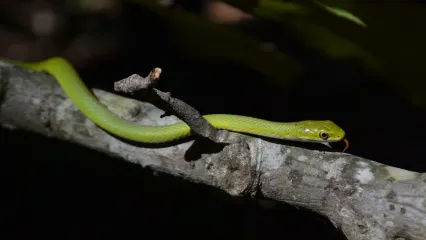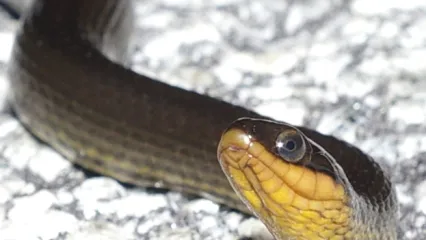
Description
Prairie lizards can be distinguished from all other Oklahoma lizards by the combination of highly keeled, pointed, and overlapping scales; no “horns” at the back of the head; and a tail longer than the body. Coloration and pattern are highly variable, even within populations. Dorsal coloration can be gray, brown, or a mixture of gray, brown, and white, and chevron-shaped lines can be present or absent. A distinct gray stripe may be present along the midline of the dorsal body surface, and well to poorly defined lighter stripes may be present on lateral body surfaces extending from the neck to the first one-third of the tail. Adult males have distinct green-blue patches bordered by black on each side of the ventral body surface. In larger males, the underside of the jaw may be black with green-blue patches on either side of the throat.
Size
Large prairie lizards reach just over 3 inches in snout-vent length. Hatchlings are about three-fourths of an inch in snout-vent length.
Habitat
Prairie lizards occur throughout Oklahoma. Their North American distribution extends from far western Nevada east to New York and from southern South Dakota in the north into Mexico to the south.
Life Cycle
Prairie lizards can be active in much of Oklahoma during any month of the year if temperatures are high enough. However, most actively occur during March-October. They can be found in almost every terrestrial habitat. The great differences among individuals in coloration and pattern are often associated with microhabitats in which individual lizards live. These are typically called “ectomorphs.” Males are territorial during the breeding season and typically defend territories on fallen logs, bases of trees, on rocks, and around shrubs. During the breeding season, males aggressively interact with other males. Mating occurs during late spring and early summer. Females deposit clutches of 6-14 eggs from early May through July, depending on annual climatic conditions. Females may deposit more than one clutch per season. Larger females produce more eggs than smaller females. Eggs are deposited in shallow burrows in the ground, under surface objects, and possibly in the walls of mammal burrows. No parental care exists. Eggs hatch from late July through September. Lifespan under natural conditions is unknown for Oklahoma populations, but individuals likely can live up to four years. These lizards eat a variety of insects, including many ants. They are ambush foragers. Because they rely on relatively high body temperatures (about 95 degrees Fahrenheit) for activity, they are often observed basking in direct sunlight, particularly during spring and fall. Their primary defensive behavior includes a combination of crypsis and escape. Background matching makes them difficult to detect, and short, rapid retreats to crevices, shrubs, or other safe harbors once they have been detected offers effective escape routes.
How To Observe
Prairie lizards are both terrestrial and arboreal and can be observed by simply remaining still for 5-10 minutes in their habitat, watching for movement on rocks, tree trunks, logs, or in open patches on the ground between shrubs. They can also be easily observed by slowly walking trails, particularly in late morning, and carefully searching microhabitats.
(This profile was created by Dr. Laurie Vitt as part of a partnership between the Wildlife Department and the Sam Noble Oklahoma Museum of Natural History. It was funded as part of a larger State Wildlife Grant to survey and inventory amphibians and reptiles of the Wildlife Management Areas of Oklahoma: T-35-P-1.)


